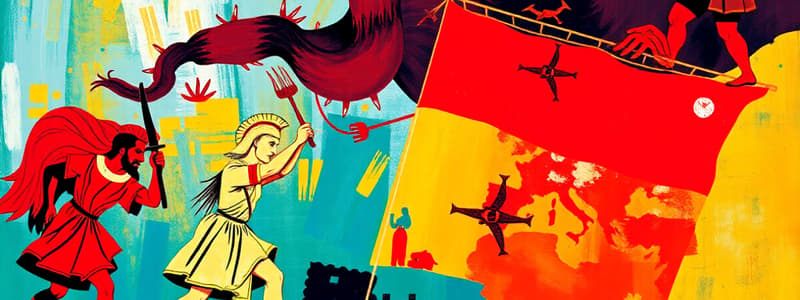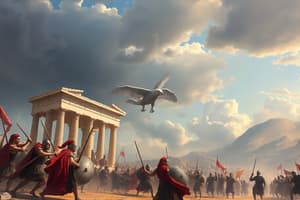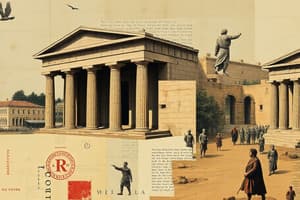Podcast
Questions and Answers
What major event marked the failure of the peace agreement between Athens and Sparta?
What major event marked the failure of the peace agreement between Athens and Sparta?
- The Sicilian expedition (correct)
- The peace of Apamea
- The rise of Persia
- The battle of Ipsos
Who was the leader of the coalition against Antigonus I Monophthalmus during the Battle of Ipsos?
Who was the leader of the coalition against Antigonus I Monophthalmus during the Battle of Ipsos?
- Antigonus I Monophthalmus
- Demetrius I
- Cassander
- Seleucus I Nicator (correct)
Which territory did Seleucus I secure as a result of his victory at the Battle of Ipsos?
Which territory did Seleucus I secure as a result of his victory at the Battle of Ipsos?
- Egypt
- Macedonia
- Syria and Mesopotamia (correct)
- Thrace
What was a key advantage for Seleucus I's coalition in the Battle of Ipsos?
What was a key advantage for Seleucus I's coalition in the Battle of Ipsos?
Which empire was established by Seleucus I after the Battle of Ipsos?
Which empire was established by Seleucus I after the Battle of Ipsos?
What event caused the complete defeat of the Athenian fleet during the conflict with Sparta?
What event caused the complete defeat of the Athenian fleet during the conflict with Sparta?
Which leader was NOT involved in the coalition against Antigonus during the Battle of Ipsos?
Which leader was NOT involved in the coalition against Antigonus during the Battle of Ipsos?
What was the significance of the Peace of Apamea?
What was the significance of the Peace of Apamea?
What were the three main goals of Cimon during his military campaign with the Delian League?
What were the three main goals of Cimon during his military campaign with the Delian League?
What significant discovery did Cimon make on the island of Scyros?
What significant discovery did Cimon make on the island of Scyros?
What triggered the Thasian Revolts in 467 BCE?
What triggered the Thasian Revolts in 467 BCE?
What consequence did Thasos face after attempting to withdraw from the Delian League?
What consequence did Thasos face after attempting to withdraw from the Delian League?
What was one of the political repercussions of Cimon's actions in Thasos?
What was one of the political repercussions of Cimon's actions in Thasos?
What strategic decision did Themistocles make regarding Athens during the Persian invasion?
What strategic decision did Themistocles make regarding Athens during the Persian invasion?
In 467, what major military success did Cimon achieve against the Persians?
In 467, what major military success did Cimon achieve against the Persians?
What was the outcome of the Battle of Salamis?
What was the outcome of the Battle of Salamis?
What was the impact of Cimon's success in battles on the Delian League?
What was the impact of Cimon's success in battles on the Delian League?
What was the primary purpose of forming the Delian League in 476 BCE?
What was the primary purpose of forming the Delian League in 476 BCE?
What did Cimon's discovery of King Theseus's bones lead to?
What did Cimon's discovery of King Theseus's bones lead to?
What contributed to the expansion of Athenian democracy following the Persian Wars?
What contributed to the expansion of Athenian democracy following the Persian Wars?
What was one significant reaction of Spartan citizens to Athenian leadership of the fleet?
What was one significant reaction of Spartan citizens to Athenian leadership of the fleet?
What was one consequence of the tribute system established by the Delian League?
What was one consequence of the tribute system established by the Delian League?
What event in 464 BCE contributed to the instability of Sparta?
What event in 464 BCE contributed to the instability of Sparta?
Which statement best describes the Athenian approach in dealing with Sparta during the helot rebellion?
Which statement best describes the Athenian approach in dealing with Sparta during the helot rebellion?
What was the significance of the Battle of Gaugamela?
What was the significance of the Battle of Gaugamela?
What was a key outcome of the King's Peace treaty signed in 387 BCE?
What was a key outcome of the King's Peace treaty signed in 387 BCE?
What was the nature of the victory at the Battle of Mantinea for Thebes?
What was the nature of the victory at the Battle of Mantinea for Thebes?
Who led the Thirty Tyrants in Athens?
Who led the Thirty Tyrants in Athens?
What characterized the regime of the Thirty Tyrants?
What characterized the regime of the Thirty Tyrants?
What was a major consequence of the King's Peace treaty for the Greek city-states?
What was a major consequence of the King's Peace treaty for the Greek city-states?
During the Battle of Gaugamela, what was the estimated size of Darius' army?
During the Battle of Gaugamela, what was the estimated size of Darius' army?
What was a significant factor in the outcome of the Battle of Mantinea?
What was a significant factor in the outcome of the Battle of Mantinea?
What role did the Federal Court play in the Achaean League?
What role did the Federal Court play in the Achaean League?
Which cities were key additions to the Achaean League under Artus's leadership?
Which cities were key additions to the Achaean League under Artus's leadership?
What was the primary impact of the Battle of Corinth on the Achaean League?
What was the primary impact of the Battle of Corinth on the Achaean League?
What was a notable feature of the Macedonian Phalanx introduced by Phillip II of Macedon?
What was a notable feature of the Macedonian Phalanx introduced by Phillip II of Macedon?
Why was the long length of the sarissa advantageous in combat?
Why was the long length of the sarissa advantageous in combat?
How did the sympoliteia impact relationships between cities?
How did the sympoliteia impact relationships between cities?
What was one of the greatest strengths of the Macedonian Phalanx during battle?
What was one of the greatest strengths of the Macedonian Phalanx during battle?
How deep would ranks typically form in a Macedonian Phalanx?
How deep would ranks typically form in a Macedonian Phalanx?
What was a significant consequence of the treaty signed at Apamea for the Seleucid Empire?
What was a significant consequence of the treaty signed at Apamea for the Seleucid Empire?
How many infantry and cavalry were the Seleucids limited to following the treaty?
How many infantry and cavalry were the Seleucids limited to following the treaty?
What was the purpose of Antiochus IV being provided as a hostage to Rome?
What was the purpose of Antiochus IV being provided as a hostage to Rome?
What was a key factor in Seleucus I's choice of location for the city of Seleukeia?
What was a key factor in Seleucus I's choice of location for the city of Seleukeia?
What impact did the Battle of Sellasia have on Spartan power?
What impact did the Battle of Sellasia have on Spartan power?
Who was the leader of the Achaean League at the time of the Battle of Sellasia?
Who was the leader of the Achaean League at the time of the Battle of Sellasia?
What was one of the policies of Seleucus I for Seleukeia?
What was one of the policies of Seleucus I for Seleukeia?
What was a requirement placed on the Seleucid Empire in terms of financial indemnity?
What was a requirement placed on the Seleucid Empire in terms of financial indemnity?
Flashcards
Thermopylae's Impact
Thermopylae's Impact
The battle of Thermopylae, despite the Greek defeat, inspired Greek unity and resistance against the Persians.
Salamis Strategy
Salamis Strategy
Athenian strategy to defend against the Persian invasion by using the narrow waters of the Salamis Strait against the Persian fleet.
Battle of Salamis
Battle of Salamis
The decisive naval victory of the Greeks against the Persians at the Salamis Strait, forcing Xerxes to retreat to Persia.
Battle of Plataea
Battle of Plataea
Signup and view all the flashcards
Delian League
Delian League
Signup and view all the flashcards
Athenian Expansion
Athenian Expansion
Signup and view all the flashcards
League Money and Democracy
League Money and Democracy
Signup and view all the flashcards
Spartan Tensions
Spartan Tensions
Signup and view all the flashcards
Cimon's Goals
Cimon's Goals
Signup and view all the flashcards
Cimon's Success and Defections
Cimon's Success and Defections
Signup and view all the flashcards
The Thasian Revolt
The Thasian Revolt
Signup and view all the flashcards
Athenian Economic Motives
Athenian Economic Motives
Signup and view all the flashcards
Tension within the Delian League
Tension within the Delian League
Signup and view all the flashcards
The Thasian Revolt's Aftermath
The Thasian Revolt's Aftermath
Signup and view all the flashcards
Political Scrutiny of Cimon
Political Scrutiny of Cimon
Signup and view all the flashcards
Cimon's Political Downfall
Cimon's Political Downfall
Signup and view all the flashcards
Battle of Gaugamela
Battle of Gaugamela
Signup and view all the flashcards
King's Peace
King's Peace
Signup and view all the flashcards
Battle of Mantinea
Battle of Mantinea
Signup and view all the flashcards
The Thirty
The Thirty
Signup and view all the flashcards
What was the Peace of Nicias?
What was the Peace of Nicias?
Signup and view all the flashcards
What factors led to the breakdown of the Peace of Nicias?
What factors led to the breakdown of the Peace of Nicias?
Signup and view all the flashcards
What was the Sicilian Expedition?
What was the Sicilian Expedition?
Signup and view all the flashcards
What was the Battle of Ipsos?
What was the Battle of Ipsos?
Signup and view all the flashcards
Who were the key players in the Battle of Ipsos?
Who were the key players in the Battle of Ipsos?
Signup and view all the flashcards
What tactical innovation contributed to the success of the coalition at Ipsos?
What tactical innovation contributed to the success of the coalition at Ipsos?
Signup and view all the flashcards
What were the consequences of the Battle of Ipsos?
What were the consequences of the Battle of Ipsos?
Signup and view all the flashcards
What was the Peace of Apamea?
What was the Peace of Apamea?
Signup and view all the flashcards
Macedonian Phalanx
Macedonian Phalanx
Signup and view all the flashcards
Sarissa
Sarissa
Signup and view all the flashcards
Achaean League
Achaean League
Signup and view all the flashcards
Sympoliteia
Sympoliteia
Signup and view all the flashcards
Federal Court of the Achaean League
Federal Court of the Achaean League
Signup and view all the flashcards
Roman-Achaean War
Roman-Achaean War
Signup and view all the flashcards
Battle of Corinth (146 BCE)
Battle of Corinth (146 BCE)
Signup and view all the flashcards
Third Macedonian War (171-168 BCE)
Third Macedonian War (171-168 BCE)
Signup and view all the flashcards
Treaty of Apamea
Treaty of Apamea
Signup and view all the flashcards
Seleukeia on the Tigris
Seleukeia on the Tigris
Signup and view all the flashcards
Battle of Sellasia
Battle of Sellasia
Signup and view all the flashcards
Cleomenes III
Cleomenes III
Signup and view all the flashcards
Antigonus III Doson
Antigonus III Doson
Signup and view all the flashcards
Seleucid Empire
Seleucid Empire
Signup and view all the flashcards
Hellenistic Period
Hellenistic Period
Signup and view all the flashcards
Study Notes
The Persian Wars
- Cyrus II conquered Lydia in 546 BCE, including its Asian trading outlet.
- Cyrus II led a conquest of Babylon in 539 BCE.
- Darius seized the Persian throne in 521 BCE.
- Ionian Greeks revolted against Persian rule in 499 BCE.
- Darius retaliated against Athens and Eretria in 494 BCE for assistance in the Ionian Revolt.
- Miltiades led the Athenian forces to victory at Marathon in 490 BCE.
- The Battle of Thermopylae in 480 BCE involved Spartan King Leonidas and his troops.
- Themistocles evacuated Athenian citizens to the island of Salamis.
- The Athenian navy defeated the Persian navy in the Battle of Salamis.
- The Battle of Plataea in 479 BCE defeated Persian forces.
- The Battle of Mycale in 479 BCE destroyed Persian remnants.
After the Persian Wars
- A sense of Hellenic identity emerged.
- The Delian League formed in 476 BCE to oppose further Persian threats.
- The Delian League was led by Athens and oversaw contributing states' provision of ships, men, or money.
- Athens benefited from the Delian League with state pay for public service, and democratic reforms reduced aristocrat power in politics.
- Athens' expansionism brought renewed tensions with Sparta.
- An earthquake in 464 BCE further destabilized Sparta, which led them to reject Athenian help.
- Sparta and Athens ultimately fought in the Peloponnesian War.
First Peloponnesian War
- Athens' expansionist policies extended, as part of democratic governance and hegemony.
- Megara left the Peloponnesian League to ally with Athens in 460 BCE.
- In 459 BCE, Corinth and Aegina combined against Athens.
- The Long Walls were built in 459 BCE to link Athens to the port of Piraeus.
- Aegina was captured by Athens in 457 BCE for its strategic location and position between Athens and the Peloponnese.
- A thirty-year peace was declared in 445 BCE.
Examination Terms
- Kimon: A prominent Athenian general during the late 5th century BCE.
- Xenophon: A general, student of Socrates, and author of Memorabilia, Cyropaedia, and Hellenica.
- Konon: An Athenian naval commander, known for his role in the final stages of the Peloponnesian War.
- Nikias: A statesman and general, known for his role in the Thirty Years Peace.
- Pelopidas: A Theban general and statesman.
- Alkibiades: A prominent Athenian general and statesman in the 5th century BCE.
- Demosthenes: A famous Athenian statesman and orator, known for his opposition to Philip II of Macedon.
- Dionysios: A tyrant of Syracuse in Sicily in the late 5th century BCE.
- Brasidas: A Spartan general, known for his military achievements during the Peloponnesian War.
- Aratos: A Greek statesman and leader of the Achaean League.
- Seleukos Nikator: An admiral and general known for his role consolidating an empire after Alexander the Great's death.
- Lysimachos: A general under Alexander and later a prominent ruler in the Hellenistic era.
- Thrasyboulos: A prominent Athenian general and statesman in the late 5th and early 4th centuries BCE.
- Isokrates: A renowned Greek orator and political philosopher.
- Flamininus: A Roman general who played a key role in defeating Philip V of Macedon in the Second Macedonian War
- Philippos III Arrhidaios: The half brother of Alexander and a figurehead ruler after his death in 323 BCE.
- Parmenion: Phillip II and Alexander's prominent general, instrumental in early campaigns.
- Olynthos: An Athenian colony located in the northern part of Chalcidice.
- Olympias: Mother of Alexander the Great, wife of King Phillip II of Macedon.
- Antigonos Gonatas: King of Macedon who consolidated power after the death of Alexander the Great (305-239 BCE).
Studying That Suits You
Use AI to generate personalized quizzes and flashcards to suit your learning preferences.




